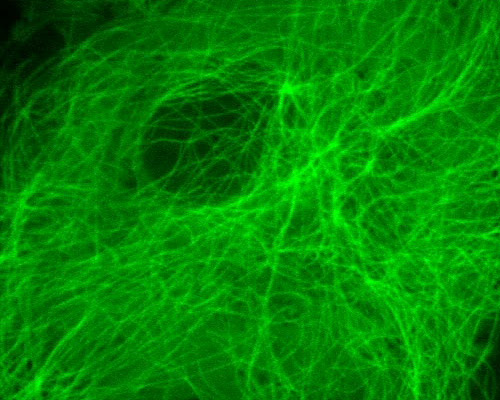Monkey Kidney Cells with mTag-GFP2 and Tubulin

Microtubules are narrow, hollow, dynamic cylinders that serve as one of the basic components of the cytoskeleton. Each microtubule in a cell is formed from a combination of homologous alpha- and beta-tubulin subunits each with a molecular weight of approximately 55 kDa. The subunits are bound together into heterodimers which are organized into 13 protofilaments. In addition to structural support, microtubules provide avenues of transport within the cytoplasm of cells and play an important role in cell division.
A microtubule has an outer diameter of roughly 25 nanometers and is considerably more rigid than an actin filament. In an archetypal animal cell, microtubules nucleate around a small region of cytoplasm that borders the cell nucleus called a centrosome or microtubule-organizing center (MTOC). From the MTOC, the filaments expand out in an astral-like configuration with their negative ends rooted in the centrosome and their positive ends positioned towards the periphery of the cell.
Microtubules were visualized in the African green monkey kidney cells (CV-1 line) featured in this digital video sequence with mTagGFP2 fused to tubulin. mTagGFP2 is a monomeric green fluorescent protein with excitation and emission maxima occurring at 483 and 506 nanometers, respectively. Though similar to GFP in level of brightness, mTagGFP2 is appreciably improved in terms of photostability. mTagGFP2 was developed from a mutant of the Aequorea macrodactyla GFP-like fluorescent protein.



